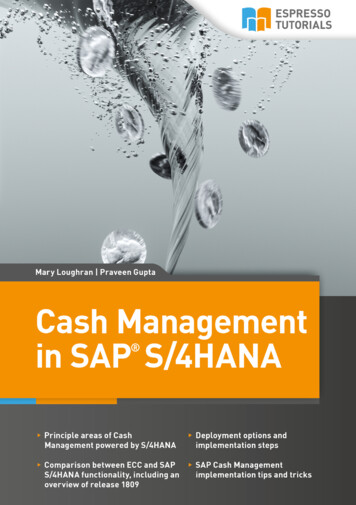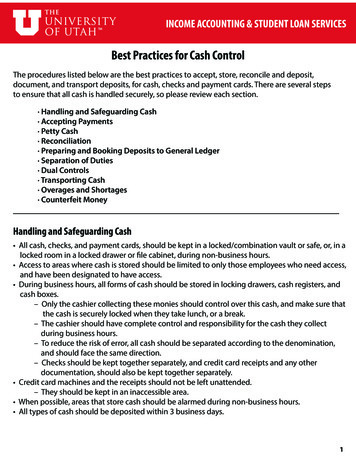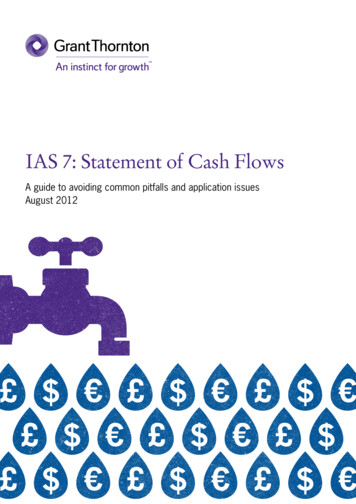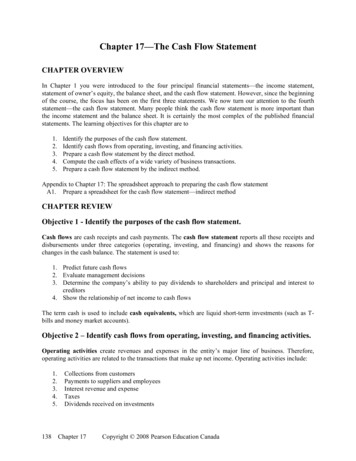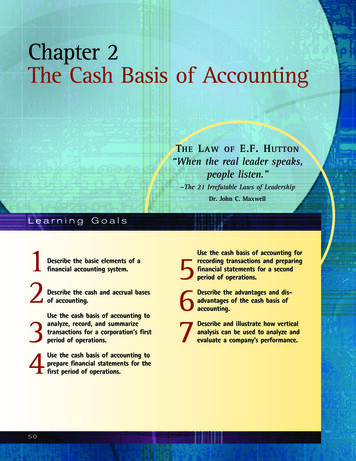
Transcription
Chapter 2The Cash Basis of AccountingT HE L AW OF E.F. H UTTON“When the real leader speaks,people listen.”—The 21 Irrefutable Laws of LeadershipDr. John C. MaxwellLearning Goals123450Describe the basic elements of afinancial accounting system.Describe the cash and accrual basesof accounting.Use the cash basis of accounting toanalyze, record, and summarizetransactions for a corporation’s firstperiod of operations.Use the cash basis of accounting toprepare financial statements for thefirst period of operations.567Use the cash basis of accounting forrecording transactions and preparingfinancial statements for a secondperiod of operations.Describe the advantages and disadvantages of the cash basis ofaccounting.Describe and illustrate how verticalanalysis can be used to analyze andevaluate a company’s performance.
51William J. Wrigley Jr. CompanyCan a company make much money by selling gum? William J. Wrigley Jr. Companydoes. During 2001, Wrigley reported net sales of 2,429,646,000 and net income of 362,986,000. In the United States, sales average 300 sticks of gum per person per year!So, what’s the attraction of gum?Scientific studies have shown that chewing gum relaxes nerves and muscles, eases tension, facilitates concentration, helps keep one alert, helps keep teeth clean, and freshensbreath. Even ancient civilizations recognized the benefits of gum. For example, the populace of early Greek civilizations chewed gum made from the bark of the mastic tree.When Wrigley began operations on April 1, 1891, it did not initially sell gum. Instead,it sold soap and baking powder. In 1892, it began giving away two packages of chewinggum with each can of baking powder as a promotion. The chewing gum became so popular that the company abandoned selling baking powder and focused on producing andmarketing chewing gum.In addition to its gum, Wrigley is famous for its corporate headquarters building onNorth Michigan Avenue, along the north bank of the Chicago River. The architecture ofThe Wrigley Building is patterned after the Seville Cathedral’s Giralda Tower in Spain.The building consists of north and south sections connected by an open arcaded walkway at the street level. A two-story clock featuring four dials appears on the building’ssouth section.The Wrigley Building is a symbol of Chicago and has appeared in numerous articles,books, movies, and television programs, including ER, My Best Friend’s Wedding, andWhile You Were Sleeping. The Wrigley name is also famous because of Wrigley Field andthe Chicago Cubs. Philip K. Wrigley, former president and CEO, at one time was a partowner of both the Cubs and Wrigley Field.William J. Wrigley Jr. Company’s history is part of the lore of Chicago. As the company moves forward, its stakeholders are interested in its future financial condition andsuccess. As we discussed in Chapter 1, the financial condition and changes in financialcondition of a business are assessed through analyzing financial statements. In this chapter, we continue our discussion of financial statements by describing and illustrating howfinancial statements are prepared under a cash basis of accounting.Source: Adapted from the William J. Wrigley Jr. Company Web site.
52Chapter 2 The Cash Basis of AccountingYour Need to KnowIn Chapter 1 we introduced you to the nature of businesses and the basic concepts of financial statements. Financial statements are critical to the proper functioning of a freemarket economy. Disclosures such as those provided by financial statements are termed“financial transparency.” Financial transparency encourages individuals to invest in businesses in which they have no direct control or ability to monitor.For example, would we be willing to invest in the stock of Lucent Technologies, Microsoft, Amazon.com, or Intel without an ability to monitor the economic performanceof the company and its management? No, we wouldn’t. However, financial statementsprovide us with the transparency necessary to monitor the performance of these companies and, thus, provide us an incentive to invest in their stocks. Likewise, financial institutions such as First Union, J.P. Morgan Chase, TIAA-CREF, Bank One Corporation,and state pension and mutual funds demand financial transparency before they are willing to loan funds to businesses.Currently, Russia is in the process of transitioning from a secret economy to a moreopen and transparent, capitalistic economy. For example, Lucoil is Russia’s largest oil company. Under communism, financial transparency was unimportant, since Lucoil had noindividual stockholders and was controlled by the state using nonpublic, internal information. However, Lucoil now needs outside capital and is considering listing its stock onthe New York Stock Exchange. In order to do so, Lucoil must move from being secretivewith its financial information to financial transparency with open publication and dissemination of its financial statements.In this chapter, we continue our discussion of financial statements and their role inenhancing financial transparency. We begin by describing the basic elements of a financial accounting system that will enable preparing financial statements. We then distinguish types of accounting systems and illustrate the simplest form of an accountingsystem based upon a cash basis. In doing so, this chapter will serve as a foundation forour later discussions of modern day accounting systems and financial reporting. However, throughout this discussion and the remainder of this text you should not forget thata primary benefit of financial reporting is its role in facilitating the functioning of a freemarket economy.Elements of an Accounting System1Describe the basicelements of a financial accountingsystem.A financial accounting system is designed to produce financial statements. You should recall from Chapter 1 that the basic financial statements are the income statement, retainedearnings statement, balance sheet, and statement of cash flows. So what are the basic elements of an accounting system that will enable the preparation of these statements?The basic elements of a financial accounting system include (1) a set of rulesfor determining what, when, and the amount that should be recorded for economic events,(2) a framework for preparing financial statements, and (3) one or more controls to determine whether errors may have arisen in the recording process. These basic elementsare found in all financial accounting systems—from a local retailer or hardware store toMicrosoft, General Motors, Boeing, and William J. Wrigley Jr. Company.RulesThe set of rules for determining what, when, and the amount that should be recorded foreconomic events are derived from the eight concepts we discussed in Chapter 1. In addi-
53Chapter 2 The Cash Basis of Accountingtion, the set of rules depends upon whether the business uses the cash basis or the accrual basis of accounting. We will describe and illustrate the set of rules for the cash basis of accounting in this chapter. The set of rules for the accrual basis of accounting aredescribed and illustrated in Chapter 3.FrameworkThe accounting equation provides a framework for recording and summarizing economicevents and preparing financial statements. You should recall from Chapter 1 that the accounting equation is expressed as follows:Assets Liabilities Stockholders’ EquityUsing this equation, accounting systems are designed to record and summarize the effectsof economic events on each element of the equation. That is, an economic event is analyzed in terms of its effect on assets, liabilities, or stockholders’ equity.A transaction is an economic event that under generally accepted accounting principles affects an element of the accounting equation and, therefore, must be recorded. Atransaction may affect only one, two, or all three elements of the accounting equation.For example, equipment purchased for cash affects only assets. That is, one asset (equipment) increases while another asset (cash) decreases. If, on the other hand, the equipmentis purchased on credit, both assets (equipment) and liabilities(accounts or notes payable) increase.The receipt of cash for capital stockBy keeping a running total of the effects of transactionsaffects what elements of the acon each element, the equation also provides a framework forcounting equation?summarizing the overall effects of a series of transactions.For example, by keeping a record of increases and decreasesTotal assets (cash) increases, and stockholders’in cash, the net change in cash can be determined for a peequity (capital stock) increases.riod. Likewise, by keeping a record of sales, the total salesfor the period can be determined.Using the accounting equation as the framework for recording and summarizing transactions also facilitates preparing financial statements. This is because the accountingequation represents all the balance sheet elements and thus the financial condition of acompany at a point in time. Changes in financial condition can be measured by analyzing changes in two balance sheets for two periods of time. By doing so, the income statement, retained earnings statement, and statement of cash flows can be prepared. Theserelationships are illustrated below for an annual accounting period ending on December31, 2004.Financial ConditionJanuary 1, 2004Changes in Financial ConditionFor the Year EndedDecember 31, 2004Financial ConditionDecember 31, 2004Balance SheetIncome StatementRetained Earnings StatementStatement of Cash flowsBalance Sheet
54Chapter 2 The Cash Basis of AccountingControlsUsing the accounting equation as a framework for designing an accounting system provides the control that, after recording transactions, total assets must equal total liabilitiesplus total stockholders’ equity. If at the end of the period the equality does not hold, thenan error has occurred in either recording or summarizing transactions. For example, if a 10,000 purchase of equipment for cash is incorrectly recorded as an increase in bothequipment and cash, the total assets will exceed the total liabilities and stockholders’ equity by 20,000 at the end of theWhen 3,000 of cash was receivedperiod. Likewise, if equipment was increased by 10,000, butfor fees earned, it was erroneouslycash was not decreased by 10,000, the total assets will exceedrecorded as an increase in cashtotal liabilities and stockholders’ equity by 10,000 at the endof 300 and an increase in reof the period. In both cases, the inequality of the equation willtained earnings (fees earned) ofindicate that an error has occurred in the recording process. 3,000. Will the accountingBefore the financial statements are prepared, errors can beequation balance?discovered and corrected. However, the equality of the equationat the end of the period doesn’t necessarily mean that no errorsNo. Total assets will be less than total liabilities plus stockholders’have occurred. For example, assume that a business purchasedequity by 2,700. 10,000 of equipment on credit and recorded the transaction asan increase in equipment of 10,000. However, instead of increasing the liabilities by 10,000, the transaction was recorded as a 10,000 decrease in cash. In this case, the accounting equation still balances, even though cash and liabilities are understated by 10,000. For this reason, accounting systems are designed with additional controls forrecording and summarizing transactions. We will discuss these controls in later chapters.Cash and Accrual Bases of Accounting2Describe the cashand accrual basesof accounting.Accounting systems are based upon either the cash basis or the accrual basis of accounting. The accrual basis is used by large businesses and is required of publicly held corporations, such as Amazon.com and Wm. J. Wrigley Jr. Company. The cash basis ofaccounting is often used by individuals and small businesses.1 For example, you probably use a cash basis because your checkbook is your primary accounting record. You keeptrack of your deposits (cash receipts) and checks (cash payments). Periodically, the banksends you a statement that you use to verify the accuracy of your record keeping.Both the cash and accrual bases of accounting use the business entity, cost, going concern, objectivity, unit of measure, adequate disclosure, and accounting period conceptsdiscussed in Chapter 1. As we will discuss in the following paragraphs, the primary difference between the cash and accrual bases of accounting involves the matching concept.Using the Cash Basis of AccountingUnder the cash basis of accounting, a business records only transactions involvingincreases or decreases of its cash. To illustrate, assume that a real estate agency sells a 300,000 piece of property on December 28, 2003. In selling the property, the agency earnsa commission of 8 percent of the selling price. However, the agency does not receive the 24,000 commission check until January 3, 2004. Under the cash basis, the real estateagency will not record the commission (revenue) until January 3, 2004.Under the cash basis, expenses are recorded only when cash is paid. For example, aDecember cellular phone bill that is paid in January would be recorded as a January ex-1 Some business may use a modified-cash or tax basis of accounting. These bases of accounting are covered in advanced accounting texts.
55Chapter 2 The Cash Basis of AccountingStrategy in BusinessGot the Flu? Why Not Chew Some Gum?acing a slumping market forsugared chewing gum, such asJuicy Fruit and Doublemint,Wm. J. Wrigley Jr. Company isreinventing itself with a strategy toexpand its product lines and introduce new chewing gum applications. Wrigley’s new productsinclude sugarless breath mints andmore powerful flavored mint chewing gum, like Extra Polar Ice. In ad-Fdition, Wrigley is experimentingwith health-care applications ofchewing gum. Wrigley’s HealthCare Division has already developedSurpass, an antacid chewing gumto compete with Rolaids and Mylanta. In addition, Wrigley is experimenting with a cold-relief chewinggum and a gum that would providedental benefits, such as whiteningteeth and reducing plaque. Giventhat the U.S. population is aging,the company figures that peoplemight prefer chewing gum to taking pills for sore throats, colds, orthe flu. The effects of these newstrategic initiatives will ultimatelybe reflected in Wrigley’s financialstatements.Source: Adapted from “A Young Heir Has New Plans atOld Company,” by David Barboza, The New York Times,August 28, 2001.pense, not a December expense. Thus, under the cash basis, the matching concept doesnot determine when expenses are recorded. That is, expenses are recorded when paid incash, not necessarily in the period when the revenue is earned.On June 30, a lawyer billed aclient for 4,000 for legalservices provided during June.The client paid 1,500 in Julyand 2,500 in August. Underthe cash basis, when are thefees earned recorded?June, 0; July, 1,500; August, 2,500Using the Accrual Basisof AccountingUnder the accrual basis of accounting, revenue is recordedas it is earned, regardless of when cash is received. To illustrate,using the preceding example, the real estate agency would recordthe commissions (revenue) of 24,000 as earned on December 28,2003, even though the check (cash) is not received until January3, 2004. Once revenue has been earned and recorded, any expensesthat have been incurred in generating the revenue are recorded andthus matched against that revenue. For example, a December cellular phone bill would berecorded in December as an increase in expenses and liabilities, even though it is not paiduntil January. In this way, the December phone expense is matched against the revenueit helped generate in December.Summary of Differences between theCash and Accrual Bases of AccountingExhibit 1 summarizes the basic differences of how revenue and expenses are recorded under the cash and accrual bases of accounting.Cash BasisAccrual BasisRevenue is recordedWhen cash is receivedWhen revenue is earnedExpense is recordedWhen cash is paidWhen expense is incurred ingenerating revenueExhibit 1Cash versus AccrualAccounting
56Chapter 2 The Cash Basis of AccountingEthics in ActionChannel Stuffingo boost earnings prior to theend of a reporting period,managers will sometimes engage in the questionable practice of“channel stuffing.” Channel stuffingTenhances revenue (accrual-basis)by persuading a distributor to takeadditional products. The practicebackfired for Lucent Technologies,which had to take back 452 mil-lion of equipment from distributors,causing a reversal of previouslyrecognized revenue.In the remainder of this chapter, we illustrate recording transactions and preparing financial statements using the cash basis of accounting. We will illustrate the accrual basis of accounting in Chapter 3. Because the cash basis is simpler, it will allow us to betterfocus on how the accounting equation is used as the framework for accounting systems.In addition, a thorough understanding of the cash basis will enhance your understandingof the accrual basis. In turn, this understanding will facilitate your ability to analyze andinterpret the financial statements of publicly held corporations prepared under the accrualbasis.Using the Cash Basis for a Corporation’sFirst Period of Operations3Use the cash basisof accounting toanalyze, record, andsummarize transactions fora corporation’s first periodof operations.Using the accounting equation as our basic framework, we will illustrate the recording oftransactions under the cash basis of accounting. We will assume that on September 1,2003, Lee Landry, M.D., organizes a professional corporation to practice general medicine.The business is to be known as Family Health Care, P.C. We describe each transaction orgroup of similar transactions during September, the first month of operations. We thendescribe how the accounting equation can be used to analyze the effects of the transactions on the financial condition of the business. We will begin with Dr. Landry’s investment to establish the business.Transaction a Dr. Landry deposits 6,000 in a bank account in the name of FamilyHealth Care, P.C., in return for shares of stock in the corporation. We will refer to stockissued to owners (stockholders) such as Lee Landry as capital stock. The effect of thistransaction is to increase the asset (cash), on the left side of the equation, by 6,000.Increases are recorded as positive numbers, while decreases are recorded as negativenumbers. Thus, the 6,000 deposit is recorded as a positive addition to Cash. To balance the equation, the stockholders’ equity (capital stock) on the right side of the equation is increased by the same amount. This 6,000 is recorded as a positive addition toCapital Stock. The effect of this transaction on Family Health Care’s accounting equation is shown below.
57Chapter 2 The Cash Basis of AccountingAssets Stockholders’ EquityCasha. 6,000Capital Stock6,000Investment by Dr. LandryNote that the equation relates only to the business, Family Health Care, P.C. Lee Landry’spersonal assets (such as a home or a personal bank account) and personal liabilities areexcluded from the equation. The business is treated as a separate entity, with cash of 6,000 and stockholders’ equity of 6,000.Transaction b Family Health Care’s next transaction is to borrow 10,000 from FirstNational Bank to finance its operations. To borrow the 10,000, Lee Landry signed anote payable in the name of Family Health Care. The note payable is a liability or aclaim on assets that Family Health Care must satisfy (pay) in the future. In addition, thenote payable requires the payment of interest of 100 per month until the note is duein full on September 30, 2009. At the end of September, we will record the payment of 100 of interest.The items in the equation prior to the borrowing transaction and the effect of the borrowing transaction are shown next. The new amounts or balances of the items are alsoshown.Assets Liabilities Stockholders’ EquityNotesCash Payablea.6,000b.10,00010,000Bal. 16,00010,000Capital Stock6,000Loan from bank6,000Observe how this transaction changed the mix of assets and liabilities but did not changeFamily Health Care’s stockholders’ equity. That is, assets minus liabilities still equals stockholders’ equity of 6,000.Transaction c Next, Family Health Care buys land for 12,000 cash. The land is located near a new suburban hospital that is under construction. Lee Landry plans to rentoffice space and equipment for several months. When the hospital is completed, Family Health Care will build on the land.The purchase of the land changes the makeup of the assets, but it does not change thetotal assets. The effect of this transaction on the accounting equation is shown below.Assets Liabilities Stockholders’ EquityNotesCash Land PayableBal.16,00010,000c. 12,00012,000Bal.4,00012,00010,000Capital Stock6,000Purchase of land6,000Transactions (b) and (c) have not improved the stockholders’ equity of Family Health Care.They have simply changed the mix of assets and increased the liability, notes payable. However, the objective of businesses is to improve stockholders’ equity through operations.
58Chapter 2 The Cash Basis of AccountingEthics in ActionPhony Shares of Stocknethical practices can occurin promoting the issuanceof stock to stockholders. Itwould be considered fraudulent toUhide known risks from potentialstockholders and to use stock proceeds for purposes other than indicated or for selling counterfeitshares. For example, two peoplepled guilty for fraudulently selling 15 million of phony shares ofMindArrow Systems, Inc., stock.How does a business improve the stockholders’ equity? By earning revenues in excessof expenses. Revenues increase stockholders’ equity through the business operations, whileexpenses decrease stockholders’ equity. When revenues for a period exceed the expensesused to earn the revenues, the financial condition of the business will have improved. Thisimprovement in financial condition results in an increase in the stockholders’ equity ofthe business. Likewise, if the expenses exceed the revenues for a period of time, the stockholders’ equity of the business will decrease. For this reason, transactions involving revenues and expenses are recorded as part of stockholders’ equity in the accounting equation.In the following paragraphs, we illustrate the recording of revenue and expense transactions for Family Health Care.Transaction d During the first month of operations, Family Health Care earns patientfees of 5,500, receiving the amount in cash. These transactions increase cash and thestockholders’ equity by 5,500, as shown below.Assets Liabilities Stockholders’ EquityNotesCash Land PayableBal. 4,00012,00010,000d.5,500Bal. 9,50012,00010,000CapitalRetained Stock Earnings6,0005,500Fees earned6,0005,500Unlike transactions (b) and (c), the stockholders’ equity of Family Health Care has increased by 5,500 as a result of this transaction. You should note that the increase instockholders’ equity from revenue is listed in the equation under “Retained Earnings.”Retained earnings is the stockholders’ equity created by the business operations (revenuesless expenses). Transactions affecting earnings are kept separate from transactions relatedto stockholders’ investments (capital stock). This is useful in preparing reports to ownersand creditors and in satisfying some states’ legal requirements that we will discuss laterin the text.Transaction e For Family Health Care, the expenses paid during the month were asfollows: wages, 1,125; rent, 950; utilities, 450; interest, 100; miscellaneous, 275.Miscellaneous expenses include small amounts paid for such items as postage due andnewspaper and magazine purchases. This group of expense transactions reduces cashand stockholders’ equity, as shown below.
59Chapter 2 The Cash Basis of Accounting Liabilities Stockholders’ EquityAssetsNotesCash Land PayableBal.9,50012,00010,000e. 2,900Bal.6,60012,00010,000CapitalRetained Stock Earnings6,0005,500 1,125 950 450 100 2756,0002,600Wages expenseRent expenseUtilities expenseInterest expenseMisc. exp.Transaction f At the end of the month, Family Health Care pays 1,500 to stockholders(Dr. Lee Landry) as dividends. Dividends are distributions of business earnings to stockholders. Dividend payments reduce cash and stockholders’ equity. The effect of this transaction is shown as follows: Liabilities Stockholders’ EquityAssetsNotesCash Land PayableBal.6,60012,00010,000f. 1,500Bal.5,10012,00010,000CapitalRetained Stock Earnings6,0002,600 1,500 Dividends6,0001,100You should be careful not to confuse dividends with expenses. Dividends do not represent assets consumed or services used in the process of earning revenues. The decrease instockholders’ equity from dividends is listed in the equation under “Retained Earnings.”This is because dividends are considered a distribution of earnings to the owners.The transactions of Family Health Care are summarized as follows in Exhibit 2. Thetransactions are identified by letter, and the balance of each item is shown after eachtransaction.Family Health CareSummary ofTransactions forSeptember Liabilities Stockholders’ EquityAssetsExhibit 2NotesCash Land Payablea.6,000b.10,00010,000Bal.16,00010,000c. 2,00010,000e. 2,900Bal.f.Bal.6,600 1,5005,10012,00010,00012,00010,000CapitalRetained Stock Earnings6,000InvestmentLoan from bank6,000Purchase of land6,0005,500 Fees earned6,0005,500 1,125 Wages expense 950 Rent expense 450 Utilities expense 100 Interest expense 275 Miscellaneous exp.6,0002,600 1,500 Dividends6,0001,100
60Chapter 2 The Cash Basis of AccountingIn reviewing the preceding illustration, you should note the following, which apply to alltypes of businesses:1.The effect of every transaction is an increase or a decrease in one or more of theaccounting equation elements.2.The two sides of the accounting equation are always equal.3.The stockholders’ equity is increased by amounts invested byA physician refunded 300 tostockholders (capital stock). In addition, stockholders’ equitya patient for an incorrect bill.(retained earnings) is increased by revenues and decreased byHow would you record thisexpenses. Finally, stockholders’ equity (retained earnings) istransaction?decreased by dividends distributed to stockholders. The effectDecrease assets (cash) 300, and decreaseof these four types of transactions on stockholders’ equity isretained earnings (fees earned) by 300.illustrated in Exhibit 3.Exhibit 3Effects of Transactionson Stockholders’EquityS TO C K H O L D E R S’ E Q U IT YFinancial Statements for a Corporation’sFirst Period of Operations4Use the cash basisof accounting toprepare financialstatements for the firstperiod of operations.Exhibit 4Family Health CareFinancial Statementsfor SeptemberIn Exhibit 2, the September transactions for Family Health Care are listed in the orderthat they occurred. This exhibit, however, is not very user-friendly in that it does notgroup and summarize like transactions together. As we described and illustrated in Chapter 1, the accounting reports that provide this summarized information are the financialstatements.The September financial statements for Family Health Care are illustrated in Exhibit 4.Family Health Care, P.C.Retained Earnings StatementFor the Month Ended September 30, 2003Net income for SeptemberLess dividendsRetained earnings, September 30, 2003 2,6001,500 1,100
61Chapter 2 The Cash Basis of AccountingExhibit 4Family Health Care, P.C.Income StatementConcludedFor the Month Ended September 30, 2003Fees earnedOperating expenses:Wages expenseRent expenseUtilities expenseInterest expenseMiscellaneous expensesTotal operating expensesNet income 5,500 1,1259504501002752,900 2,600Family Health Care, P.C.Balance SheetSeptember 30, 2003AssetsCashLandTotal assets 5,10012,000 17,100LiabilitiesNotes payable 10,000Stockholders’ EquityCapital stockRetained earningsTotal liabilities and stockholders’ equity 6,0001,1007,100 17,100Family Health Care, P.C.Statement of Cash FlowsFor the Month Ended September 30, 2003Cash flows from operating activities:Cash received from customersDeduct cash payments for expensesNet cash flow from operating activitiesCash flows from investing activities:Cash payments for acquisition of landCash flows from financing activities:Cash received from sale of cap. stockCash received from notes payableDeduct cash dividendsNet cash flow from financing activitiesNet increase in cashSeptember 1, 2003 cash balanceSeptember 30, 2003 cash balance 5,5002,900 2,600(12,000) 6,00010,000 16,0001,50014,500 5,1000 5,100
62Chapter 2 The Cash Basis of AccountingThe data for the statements were taken from the transactions summary shown in Exhibit2. You should note that each financial statement is identified by the name of the business, the title of the statement, and the date or period of time.Income StatementAs shown in Exhibit 4, the income statement for Family Health Care reports fees earnedof 5,500, total operating expenses of 2,900, and net income of 2,600. The 5,500 offees earned was taken from the Retained Earnings column of Exhibit 2. Likewise, the expenses were summarized from the Retained Earnings column of Exhibit 2 and reportedunder the heading “Operating expenses.” The expenses were listed in order of size, beginning with the largest expense. Miscellaneous expense is usually shown as the last item,regardless of the amount. The total operating expenses were then subtracted from the feesearned to arrive at the net income of 2,600. The effect of this net income will be to increase retained earnings and stockholders’ equity.Retained Earnings StatementSin
The Cash Basis of Accounting THE LAW OF E.F. HUTTON "When the real leader speaks, people listen." —The 21 Irrefutable Laws of Leadership Dr. John C. Maxwell Learning Goals 1 Describe the basic elements of a financial accounting system. 2 Describe the cash and accrual bases of accounting. 3Use the cash basis of accounting toanalyze, record .



